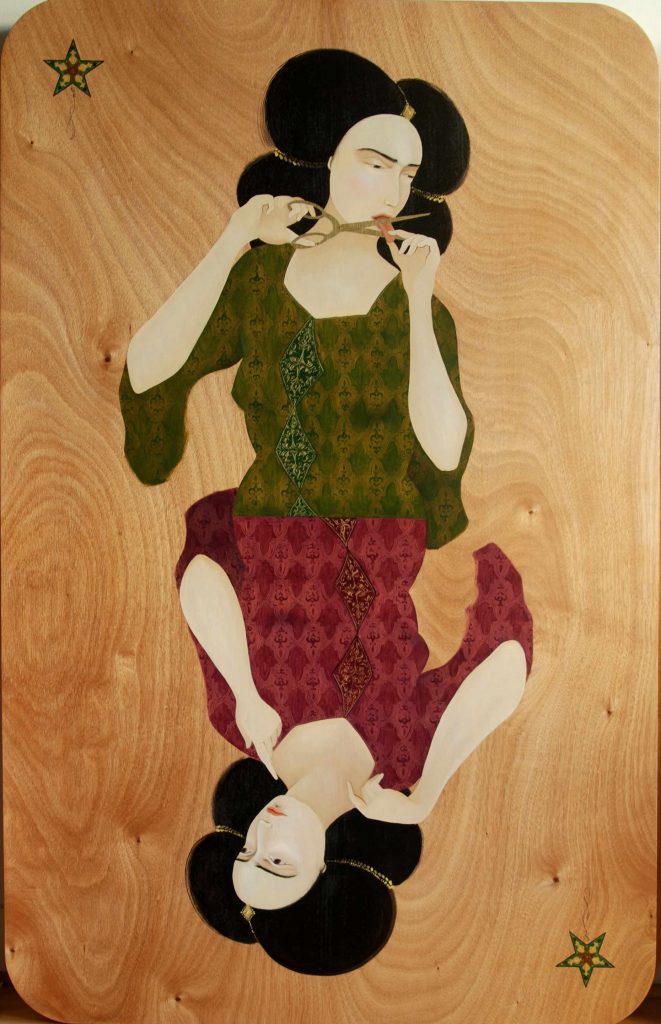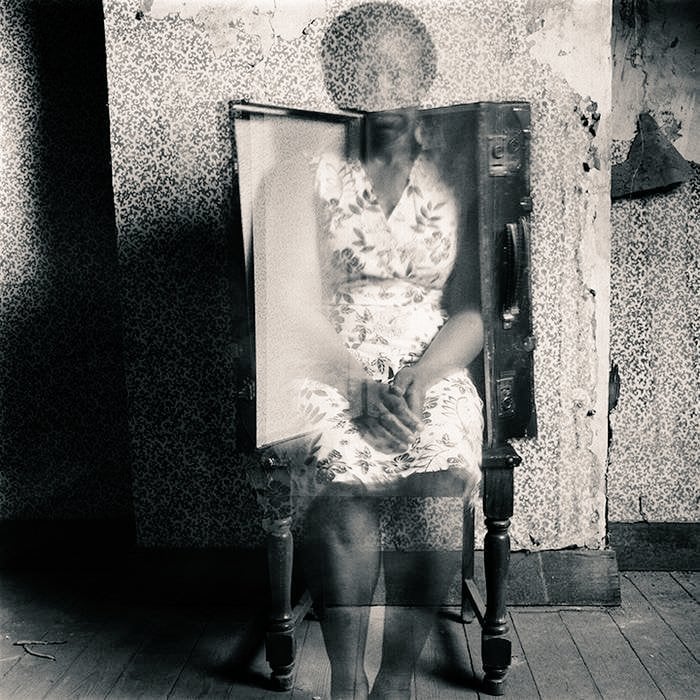In: Immigrants

Hayv Kahraman | Migrant 3, 2009
September 29, 2022Hayv Kahraman | Migrant 3, 2009
Oil on panel 70 x 45 in. (177.8 x 114.3 cm.)
Hayv Kahraman was born in Baghdad, Iraq, in 1981 but now lives and works in Los Angeles. She describes her work as being “a vocabulary of narrative, memory and dynamics of non-fixity found in diasporic cultures are the essence of her visual language and the product of her experience as an Iraqi refugee / come émigré. The body as object and subject have a central role in her painting practice as she compositely embodies the artist herself and a collective.”
This work was made around the same time as her series Marionettes which “explores this subject of female oppression with particular reference to war in the Middle East and specifically in her home land of Iraq. At the same time, she turns her attention to female subjugation found in the everyday, in a series of work focused on women and domestic life. Enslavement is depicted through strings controlling the movement of the women; they drift through the landscapes seemingly oblivious to, or accepting of, their fate.” (from a review in Contemporary Practices, 2010)
This image, as I was engaged in my frequent research about contemporary artists, caught my eye not just for its evocative if disturbing scene (that might be an act of self censorship, or a visual metaphor for a prohibition to speak or be heard), but also with what’s happening in Iran, right now. Feminism – that idea, affronting to so many, that people are all equal – is a contested narrative with overlapping and challenging voices, whether you’re listening to Hurston, Dworkin, Solanas, hooks, Simpson or Deer.
When geo politics enter the conversation – as with spaces where religion is a defining factor, such as the Middle East or the United States, lumbering like a rough beast towards not so much Jerusalem as Atwood’s Gilead – it only becomes more important to allow it to be defined personally, as, “the personal, as everyone’s so fucking fond of saying, is political.” (from the writings of Quellcrist Falconer, the founder of the Quellist movement, in Richard K. Morgan’s Altered Carbon)
As the work is titled Migrant 3, Kahraman might be ‘speaking’ of Iraq or of her new home, in the United States, just as the mirrored figures have differences, as time and experience takes upon any sense of self.
More of Hayv Kahraman’s work can be seen at both her IG and her site.
~ Bart Gazzola
Read More
Hélène Amouzou | Between the Wallpaper and the Wall, Belgium / Togo, 2004-2011
March 24, 2022Hélène Amouzou | Between the Wallpaper and the Wall, Belgium / Togo, 2004-2011
Foreigners forget their place (having left it behind). Given time, they begin to think of themselves as our equals. It is an unavoidable hazard. (Salman Rushdie, Christopher Columbus and Queen Isabella of Spain Consummate Their Relationship, Santa Fe, January, 1492, from his book East, West)
Rushdie’s characters are dripping with entitled sarcasm, in that story I cited. They could never imagine themselves as being foreign, or displaced, or not the gatekeepers – or the owners – of a place. Hélène Amouzou’s images from her series Between the Wallpaper and the Wall, Belgium/Togo, 2004-2011 originate from the opposite side of that conversation, and the ghostly, ephemeral nature of her self portraits speaks to a doubt, a dismissal, even, that is too often the immigrant experience.
“They describe us,” the other whispered solemnly. “That’s all. They have the power of description, and we succumb to the pictures they construct.” (Rushdie, again, from the chapter Ellowen Deeowen, of The Satanic Verses, entailing the suffering of immigrants in a manner that is both a casual brutality and magical realism, where words become reality. If you’re familiar with this text, the idea that someone might fade from sight, like dissipating mist if willfully ignored, fits right in….).
Inspired by the work of Francesca Woodman, Hélène Amouzou creates her own distinctive and haunting imagery, which speaks of the contemporary issue of the displacement of people and those in exile. Born in Togo, Amouzou now lives and work in Belgium. The photographs were taken during a two year period when Amouzou was seeking asylum there and waiting for her official residency visa. She captures herself or her belongings (often her clothes) in an empty room with peeling floral wallpaper. In many of the images she includes a suitcase as a recurrent symbol of her state of flux and transit. She works with film rather than digital media, preferring the effects of chance and serendipity and she exploits the use of long exposures, playing with the photographic medium to create ephemeral and ghostly self-portraits. “Self-portraiture is a way of writing without words,” Amouzou says. “My aim is to reveal the deepest parts of myself.”
These photographs reveal a constant questioning and search for the subject’s identity. Notions of freedom and legitimacy are explored in a world of bureaucracy and inequalities. Amouzou captures feelings of exclusion and the stigmatization by the lengthy official process. Those with permanent residency rights can only imagine the insecurity and daily worry of the possibility of being sent back to an unsafe place and the photographs reveal this sense of impermanence. Her ghostly images haunt each frame and hover in the no-man’s land between absence and presence. (from Juxtapoz)
More of Hélène Amouzou’s work can be seen here. ~ Bart Gazzola
Read More
Recent Comments